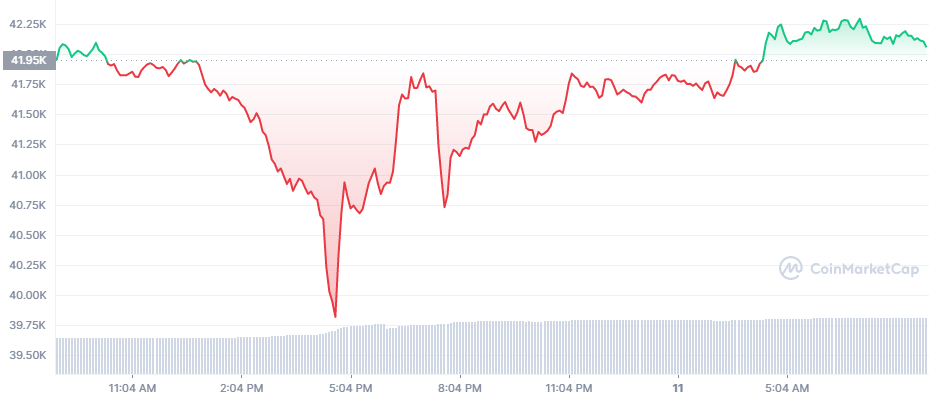Bitcoin (BTC) Back to Liquidations, Flash Crash

Bitcoin (BTC) crashed under $41,000 late on Monday, causing a cascading liquidation event once again, despite indications the market price found temporary support. BTC dipped to $39,816.94 with a sudden deep crash from just under $42,000, attacking leveraged positions.
After the flash crash, BTC stabilized again at $41,125.28.
The latest price dip extends a series of crashes happening with frequency since December 3, with no trend reversal in sight. BTC only managed to bounce off its lowest daily position, with no guarantee of regaining a higher tier.
The BTC crash had repercussions throughout the market, sending Ethereum (ETH) to a low of $2,945.45, later followed by a recovery to $3,112.05.
The flash crash event extended to other major coins and tokens, possibly amplified by automated bot trading. Flash crash events are also weighing down exchanges with smaller volumes, causing local anomalies.
The almost daily slides have happened for both major and minor assets in the past week. While there is still no official announcement of a bear market, and BTC is actually still rather bullish compared to March 2020, the current situation is becoming worrying to traders.
The latest unexpected price crash led to significant liquidations, at more than $217M in value across all markets for four hours late on Monday. At the same time, the Crypto Fear and Greed Index indicator is back at 23 points, a not unusual level after a dip to 9 points.
Still Hopes for BTC Supercycle
The recent BTC bull market, starting off from the liquidation cascade in March 2020, has continued for one of the longest periods on record. BTC can still attempt to follow predictions of a higher valuation based on supply available, but for now, levels above $69,000 remain the all-time record.
For now, BTC has broken previous expectations that the market bottom was made around $47,000. The latest dip shows the trend reversal is not as easy.
At the same time, there are hopes the dip under $40,000 was the capitulation and liquidation event to trigger a change of direction.
BTC Liquidations Work Both Ways
The extreme price moves worked in both directions, as BTC only took hours to move between a low around $39,000, and to quickly regain the $41,500 position.
The upward price move led to immediate liquidations of short positions on the Binance exchange and other derivative markets. But the other series of liquidations revealed multiple traders had taken long positions in expectation of BTC resuming its rally. The recent market crash liquidated a record share of long positions, as noted by Glassnode.
The recent price dip, however, may have moved attitudes to expect additional corrections and possibly a bear cycle down to a lower price tier.
Will BTC Buying Resume
In the past year, closely-held coins and coins taken off exchanges added to the scarcity.
Based on the BTC rainbow chart, the asset remains relatively cheap, but has not entered the phase for active accumulation. BTC remains above the level at which Tesla, Inc. entered the market, at around $38,000 per coin.
Recovery Arrived Fast
This time around, liquidations affected mostly BTC and ETH. For altcoins, some continued their upward pace, while others only had a small slide. After last week’s corrections, altcoins have not rallied, but some have stopped their losses.
ETH quickly recovered closer to the $3,100 level, while Near Protocol (NEAR) continued on its expansion and traded above $15.
This time around, however, BTC did not immediately trigger buying for El Salvador’s state treasury, or other signs of active demand during the dip. At the same time, the third-largest BTC wallet last added a few thousand coins, to hold 122,540 BTC. The latest inflow to the wallet was on January 8.
Inflow to Exchanges Resumes
Inflow of BTC to exchanges was renewed, after periods where coins were taken to private wallets with slower signs of selling. Now, data shows some traders are trying to sell on the open market.
The same trend does not apply to ETH, which remains locked in smart contracts, collaterals or is being taken off exchanges.
One of the expectations for 2022 would be that ETH would overtake BTC in both importance and price action, with the potential to gain permanently higher valuations. The ETH 2.0 launch, though without a set date, may also boost price expectations.
The ETH 2.0 smart contract already holds more than 8.9M coins, which are taken off the market with no way to return before the launch of the new staking mechanism.
ETH, however, has fallen from its peak in Satoshi valuations, down to 0.073 BTC with a downward trend.

Uphold makes buying crypto with popular currencies like USD, EUR and GBP very simple with its convenient options to swap between crypto, fiat, equities, and precious metals.

With over 50 coins and an obsession with security, Kraken is one of the safest places to buy and trade crypto.

Kraken has a good reputation for security and protection of your funds and operates across the USA (except NY), Canada, the EU and Japan

Based in Charleston, South Carolina. Serves over 184 countries and has done over $4 billion in transactions. Offers convenient options to swap between crypto, fiat, equities, and precious metals.

What do members of the public think about Crypto in 2021/22? We survey some UK people and look at search data with some surprising results.

Eight ways to buy Bitcoin without needing ID or giving personal information

An early alternative to Bitcoin, LTC aimed to be a coin for easy, fast, low-fee spending. LTC offers a faster block time and a higher transaction capacity in comparison to Bitcoin.

The leader in programmable money, smart contracts and decentralised applications. There have been many copycats but none have the community and level of adoption.